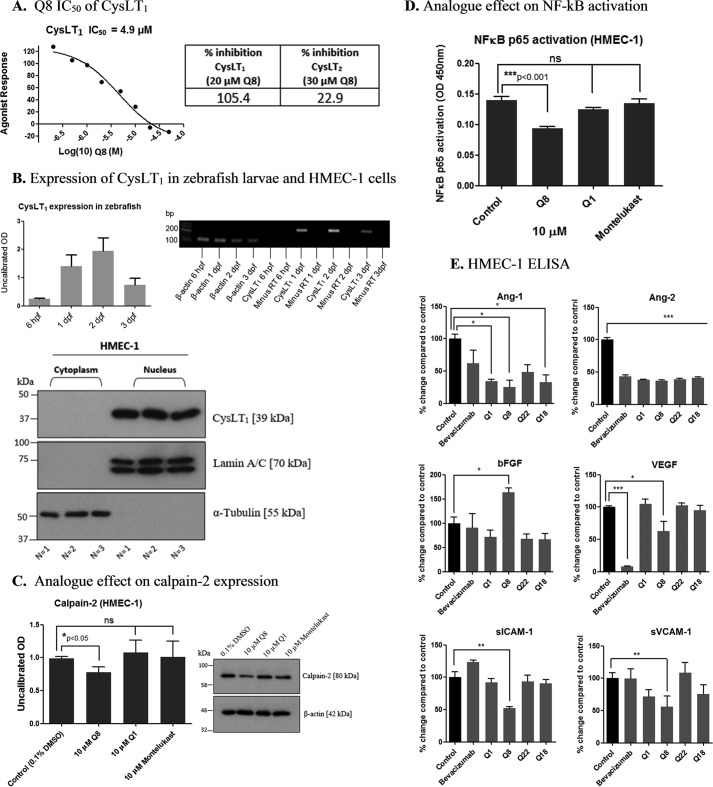FIGURE 6.
Quininib analogue Q8 is a cysteinyl leukotriene receptor-1 antagonist that affects inflammatory and angiogenic signaling pathways. A, the CysLT1 receptor IC50 of analogue Q8 was determined to be 4.9 μm following testing in a cell-based CysLT1 receptor antagonist assay in CHO cells (Eurofins Cerep SA). The assay measured calcium mobilization using fluor-3-loaded CHO cells overexpressing CysLT1 and stimulated with the CysLT1 receptor antagonist LTD4. 20 μm Q8 inhibited CysLT1 activation by 105.4%. In contrast, 30 μm Q8 produced only a 22.9% antagonism of CysLT2 receptor activation in HEK-293 cells. Thus, Q8 was excluded as a tangible CysLT2 antagonist as results showing an inhibition lower than 50% were not considered significant. Treatment of cells for individual experiments was carried out in duplicate, and each experiment was conducted 3 times (n = 3). B, CysLT1 is present in our angiogenesis models shown by the presence of the CysLT1 transcript in zebrafish larvae at 6 hpf, 1 dpf, 2 dpf, and 3 dpf following PCR and the presence of the nuclear form of the receptor in HMEC-1 endothelial cells by Western blotting. PCR was carried out using RNA isolated from larvae during three separate experiments (n = 3), and Western blotting was conducted three separate times using protein lysates from cells treated in duplicate during three separate experiments (n = 3). C, Western blot of HMEC-1 cells treated for 5 h with 0.1% DMSO or 10 μm Q1, Q8, and montelukast. Expression of calpain-2, a putative calcium-sensitive downstream target of CysLT1 signaling and proangiogenic mediator, is reduced following treatment of endothelial cells with 10 μm Q8. Calpain-2 Western blotting was conducted on protein lysates from cells treated during three separate experiments (n = 3). D, the levels of activated NF-κB p65 were significantly reduced following treatment of HMEC-1 cells with 10 μm Q8 for 5 h, whereas treatment of cells with 10 μm Q1 or the clinically used CysLT1 antagonist montelukast for 5 h had no effect on levels of activated NF-κB p65. NF-κB p65 ELISA was conducted using protein isolated from cells treated on three separate occasions in duplicate (n = 3). E, ELISA of HMEC-1 endothelial cell-conditioned medium following 16-h treatment of cells with 10 μm Q1, Q8, Q22, and Q18 revealing significant reductions in important proangiogenic mediators angiopoietin-2, VEGF, ICAM-1, and VCAM-1. Compared with other analogues of Q1, Q8, our highest ranking analogue, was the only compound to significantly reduce soluble ICAM-1 (sICAM-1), soluble VCAM-1 (sVCAM-1), and VEGF. Conditioned medium collected from three separate experiments was analyzed in duplicate by ELISA (n = 3). Statistical analysis was performed by ANOVA, Dunnett's post hoc multiple comparison test, and Student's t test. Error bars are mean ± S.E. *, p < 0.05; **, p < 0.01; ***, p < 0.001.

